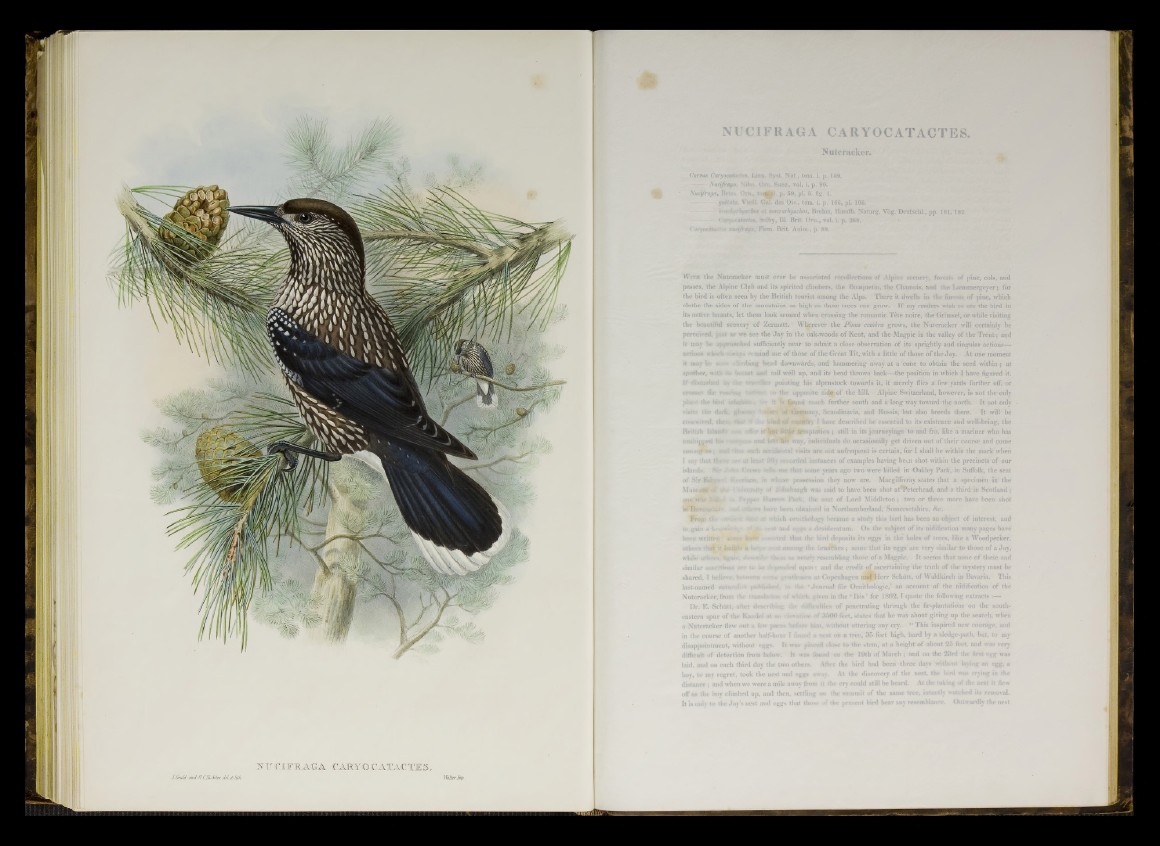
JTTTCIPRAGA CABS'© CAIACTJES.
J.Gnild anil-WC.Birhtcr, (IcLdilith
NUCIFRAGA C ARYOC ATACTES.
Nutcracker.
i. Sy»t. Nat., tom. i. p. 159.
>ro. Suec., vol. i. p. 90.
p. 59, pi. 5. fig. 1.
ial. dee Ois., tom. i. p. 166, pi. 105.
?t macrorhynchos, Brehm, Handb. Naturg. Yog. DeutschL, pp. 181,182.
ciby, 111. Brit. Or«., vbl. i. p. 368.
lem. Brit. Aijirn., p. 88.
W it h the Nutcracker mast ever be associated recollections o f Alpine scenery, forest* o f pine, cols, and
passes, the Alpine Club and its spirited climbers, the Bonquetiu, the Chamois, and th e Ltemmergeyer; for
the bird is often seen by the British tourist among the Alps. There it dwells in the forests o f pine, which
clothe the sides of the mountains as high as those trees can grow. If my readers wish to s e e the bird in
its native haunts, let them look around when crossing the romantic Tete noire, the Grimsel, or while visiting
the beautiful scenery of Zermatt. Wherever the Pituis cembra grows, the Nutcracker will certainly be
perceived, j»»t as we see the Jay in the oak-woods of Kent, and the Magpie in the valley of the Trent; and
it may be approached sufficiently near to admit a close observation of its sprightly and singular actions—
actions wlweb remind me of those of the Great Tit, with a little of those of the Jay. At one moment
it in«y be < limbing head downwards, and hammering away at a cone to obtain the seed within; at
•j- ■ >ther, -.v . yt» breast oad tail well up, and its head thrown back—the position in which I have figured it.
If disturb«» in the ?ry ■■■.-' pointing his alpenstock towards it, it merely flies a few yards further off, or
the roarww to the opposite side of the hill. Alpine Switzerland, however, is not the-only
‘hr bin: ¡ ¡ d i ; ; • is found much further south and a long way toward the north. It not only -
viwti the dark rw* »f Gewnuiiv, Scandinavia, and Russia, but also breeds there. It will be
conceived, the*. due miF of I have described be essential to its existence and well-being, the
British IslaotM («s . -..4. r it but iiutt' temptation ; still in its journeying* to and fro, like a mariner who has
unshipped hi» ■ - and foM- JiH- way, individaals do occasionally get driven out of their course and come
an^ 'iisf'os: »has >tK*h necideutai visits are not unfrequcnt is certain, for I shall be within the mark when
1 say that there ,-rr at least fdey m'ordcd instances of examples having been shot within the precincts of our
islands, Str me that some years ago two were killed in* Oakley Park, in Suffolk, the seat
of Sir . Kcmso*K in whose jsosse&sion they now are. Macgillivray states that a specimen in the
Muse«.*«! # . nm«mty ' KJinburgh was said to have been shot atnPeterhead, and a third in Scotland;
CHie!#^ vSthd H arrow l*arfc, the seat of Lord Middleton; two or three more have been shot
i f fiBVtisiifci’ -. ■*U. • bare been obtained in Northumberland, Somersetshire, &c.
Ftoa) *.?'! ?$ih« xi which ormthologv became a study this bird has been an object of interest, and
to. gain a \ .v., ifc. :-.i and egg* a desideratum. On the subject of its nid ideation many pages have
been written : aw®e .• - m-d that the bird deposits its eggs in the holes of trees, like a Woodpecker,
other) ‘hat it build» a .wst among the branches; some that its eggs are very similar to those of a Jay,
while o dKf^hw». them as nearly resembling those of a Magpie. It seems that none of these and
similar Msnerrions arc to ¿h'pended upon ; and the credit of ascertaining the truth of the mystery must be
shared, I believe, between **><5»* gentlemen at Copenhagen and Herr Schutt, of Waldkirch in Bavaria. This
last-named natursJi'-t publwbed. m the ‘ Journal fur Ornithologie,’ an account of the nidification of the
Nutcracker, from the iranslium» of which, given in the ‘ Ibis ’ for 1862,1 quote the following extracts :—
Dr. E. Schutt, after describing rfce difficulties of penetrating through the fir-plantations on the southeastern
spur of the Kandei at a« etevatioB <d’ 3560 feet, states that he was about giving up the search, when
a Nutcracker flew out a few pa«-« bdfotf* him, without uttering any cry. “ This inspired new courage, and
in the course of another half-hour I found a nest on a tree, 36 feet high, hard by a sledge-path, but, to my
disappointment, without eggs. It was placed dose to the stem, at a height of about 25 feet, and was very
difficult of detection from below. It was found on the 19th of March ; and on the 23rd the first egg was
laid, and on each third day the two others. After the bird had been three days without laying an egg, a
boy, to my regret, took the nest and eggs away. At the discovery of the nest, the bird was crying in the
distance ; and when we were a mile away from it the cry could still be heard. At the taking of the nest it flew
off as the hoy climbed up, and then, settling on the summit of the same tree, intently watched its removal.
It is onlv to the Jay’s nest and eggs that those of the present bird bear any resemblance. Outwardly the nest